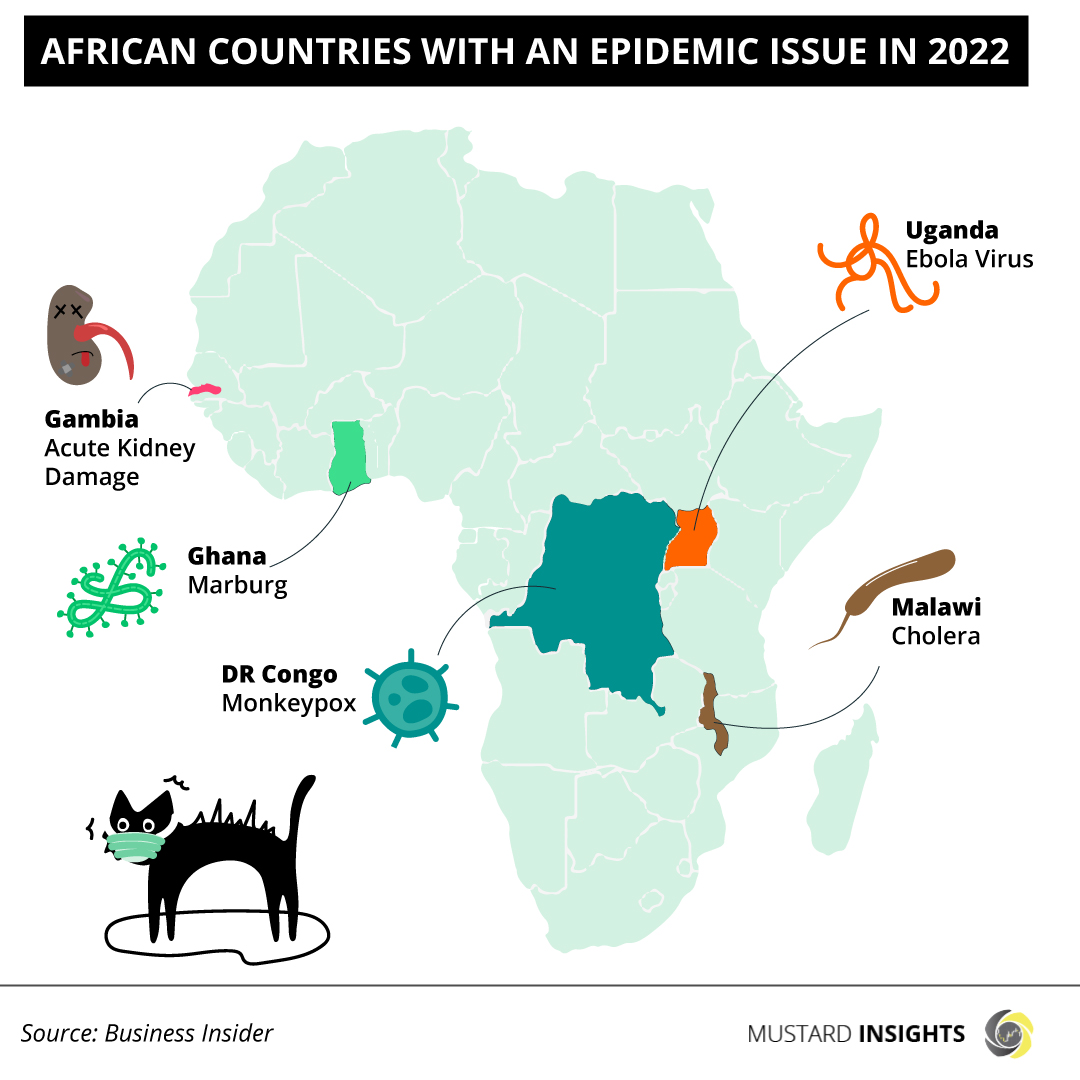Africa has had its fair share of epidemics across the continent both in its recent and distant past. From the epidemic of trypanosomiasis (sleeping sickness) that broke out in Busoga, Uganda in the 1900’s, claiming the lives of over 250,000 people, to Monkeypox in the 1950’s, which was endemic to Central and Western African countries, plaguing their population without access to recurse. Monkeypox, Ebola, are among various epidemics African countries face.

Africa has had its fair share of epidemics across the continent both in its recent and distant past. From the epidemic of trypanosomiasis (sleeping sickness) that broke out in Busoga, Uganda in the 1900’s, claiming the lives of over 250,000 people, to Monkeypox in the 1950’s, which was endemic to Central and Western African countries, plaguing their population without access to recurse.
Currently, some African countries are still having to deal with the adverse effects of Covid-19 while still battling the various other epidemics attacking the health and wellness of their citizens. Uganda is currently dealing with another outbreak of the Ebola virus. Fresh cases were first reported on the 20th of September 2022, when the Ministry of Health in Uganda, along sides the WHO, confirmed an outbreak in Mubende District, Uganda, after which one fatality was confirmed. Since then, nine other Ugandan districts have been confirmed to have been affected by this Ebola outbreak: Bunyangabu, Jinja, Kagadi, Kampala, Kassanda, Kyegegwa, Masaka, Mubende, and Wakiso. Bunyangabu, Kagadi, Kyegegwa and Masaka.
According to the World Health Organization (WHO), as of 13 December 2022, there have been 141 confirmed cases of Ebola, of which 55 died – showing a case fatality rate (CFR) of 39% - and 87 recovered. In addition, 22 deaths among probable cases have been reported in individuals who died before a sample was taken. Additionally, at least 19 healthcare workers have been infected and seven of them have died. The weekly number of confirmed cases reported decreased for the third consecutive week after the peak observed in the week 17-23 October. On the 7th of November, five confirmed and one probable case was reported, including one confirmed case and one probable death from a newly affected district (Jinja), in the Eastern Region of Uganda, which is 80 km distant from Kampala. The most recent confirmed case was reported by the Uganda MoH on 14 November, from Kampala district.
Monkeypox – Democratic Republic of Congo
The Democratic Republic of Congo has been battling with Monkeypox for some time now. Monkeypox is a rare zoonotic disease (transferred between humans and animals), caused by the monkeypox virus, which belongs to the Poxviridae family, Chordopoxvirinae subfamily, and Orthopoxvirus genus. The first case in humans was diagnosed in 1970 in a 9-month-old baby boy in Zaire (now the Democratic Republic of the Congo, DRC. Since that time, this monkeypox has become endemic in the DRC, and has spread to other African countries, mainly in Central and West Africa. Outside of Africa, the first reported monkeypox cases were in 2003 and, at the time of systematic review, the most recent cases were in 2019.
There are two distinct clades of monkeypox virus, the Congo Basin clade, and the West African clade. Monkeypox due to the Congo Basin clade virus has seen reported mortality of up to 10% of cases, whereas the West African clade usually displays fatal outcomes in less than 1% of cases. HIV infection appears to increase the risk of death in people infected with monkeypox virus.
The first epidemic peak was observed at the beginning of March 2020, with 136 cases reported weekly. From 1 January through 7 August, the Institut National de Recherche Biomédicale (INRB) received 80 samples from suspected cases of monkeypox, of which 39 samples were confirmed positive by polymerase chain reaction. Four out of the 80 specimens were skin lesions (crusts/vesicles), the remaining samples were blood.
From 1 January – 20 November 2022, the Democratic Republic of the Congo reported 4 984 suspected including 206 confirmed cases from 177 health zones across 23 provinces. The most affected provinces in 2022 are Sankuru (2 015), Tshopo (800), Kwango (332), Maniema (331), and Kasai (322).
Marburg Virus Disease - Ghana
Marburg Virus Disease (MVD) attacked Ghana, when the Ministry of Health of Ghana declared the outbreak on 7 July 2022, after confirmation of Marburg virus on 1 July 2022 in a 26-year-old male (the index case) by reverse transcriptase polymerase chain reaction (RT-PCR) at Noguchi Memorial Institute for Medical Research (NMIMR). MVD is an epidemic-prone disease associated with high case fatality ratios (CFR; 24-88%). Between 28 June and 16 September 2022, the Ministry of Health of Ghana reported three confirmed cases of Marburg Virus Disease (MVD) including two deaths (CFR: 67%). All three cases were from the same household.
Ghana successfully contained the epidemic by the 16th of September 2022, when the Ministry of Health (MoH) of Ghana declared the end of the Marburg Virus Disease (MVD) outbreak that affected the country’s Ashanti, Savannah and Western regions.
Cholera - Malawi
Cholera is endemic in Malawi, with cases occurring seasonally during the wet season. This problem has been persistent since 1998, with significant morbidity and mortality in affected populations, especially in the Southern region. The current outbreak can trace its origins to that region, beginning in March 2022. Cases were reported in the Nsanje and Machinga districts and has proceeded to affect 27 of 29 districts of Malawi, the largest outbreak reported in the country in the past ten years.
On the 3rd of March 2022, the Ministry of Public Health of Malawi notified the WHO of a cholera outbreak after laboratory confirmation of a cholera case in Machinga district hospital on 2 March 2022. Between the 3rd of March and the 31st of October 2022, a cumulative total of 6056 cases including 183 deaths have been reported from 27 of 29 districts in Malawi (CFR: 3.0%) with active transmission ongoing in 23 districts as of 31 October. Five districts account for 79% of the reported cases and 68% of the deaths: Nkhata Bay (1128 cases and 31 deaths), Nkhotakota (811 cases and 40 deaths), Rumphi (783 cases and 13 deaths), Karonga (683 cases and 14 deaths), and Blantyre (650 with 26 deaths).
Acute Kidney Damage - Gambia
Gambia was faced with an epidemic that affected children younger than 5 years of age. On August 8, 2022, the Epidemiology and Disease Control (EDC) Unit of Gambia’s Ministry of Health, published a situational report on the Acute Kidney Injury (AKI). The condition was observed among 32 children below 5 years, resulting in the deaths of 28 children.
On the 26th of July 2022, the Epidemiology and Disease Control (EDC) unit received a report through the Director of Health Services from a concerned nephrologist of a sudden rise in cases of AKI among children aged 5 months – 4 years. They were caused by four medicines of cough and cold syrups produced by Maiden Pharmaceuticals Limited in India, WHO said.
Takeaway
While the onset of epidemics might be unpredictable and sudden, it is still possible to reduce the chances that one occurs. Proper hygiene, improved sanitary conditions, and overall better sanitary living conditions might take away the environment which can fester viruses. Upon onset, early reporting of symptoms, a willingness to seek medical aid, and access to healthcare can stymie viral spread early. In time, preventative vaccination such as that which has eliminated polio may come to eliminate epidemic diseases altogether. All of these will demand a capable healthcare system and education, especially in sensitization of the general public about hygiene, disease symptoms, and the usefulness of vaccination.
Thoughts?
We won't share your email address. All fields are required.
